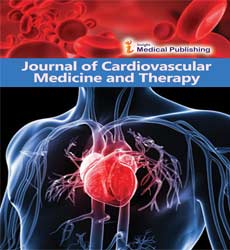The Role of Oxidized Phospholipids and Hdl
Zoey elise
Department of Cardiovascular Medicine and Therapy, Bakhtar University, Afghanistan
- *Corresponding Author:
- Zoey elise
Department of Cardiovascular Medicine and Therapy, Bakhtar University, Afghanistan
Tel no: 8179443481
E-mail: elisezoey1212@gmail.com
Received Date: December 03,2021; Accepted Date: December 16,2021; Published Date: December 23,2021
Citation: EliseJ Z (2021) The Role of Oxidized Phospholipids and Hdl. J Cardiovasc Med The Vol:4 No:3
Perspective
One of the oldest and most independent cardiology journals is the International Journal of Cardiology. Much has happened in the world of cardiology since it was first published, including mega-trials, stents, cardiac resynchronization, implantable defibrillators, stem cells, gene therapy and genetic diagnostics. Heart defects account for over a third of all severe congenital malformations with Congenital Heart Disease (CHD) afflicting around 9 out of every 1000 live new-borns globally. Exceptional advances in care have resulted in significant increases in survival with over 90% of children with CHD in affluent nations now projected to live to adulthood. As a result, population demographics have shifted dramatically in recent decades with adults now outnumbering youngsters with CHD. According to population-based estimates, there are currently over 1 million adults in the United States, over 100,000 in Canada and 1.8 million in Europe who have CHD. Rhythm abnormalities, which include all types of Brady- and tachyarrhythmia’s, are one of the most common problems that adults with CHD face.
Clinical studies co-authored by industry employees have been published in academic, peer-reviewed medical publications. Despite the fact that the practise is still controversial due to potential Conflicts Of Interest (COI), the relationship between Industry-Employee Authors (IEAs) and trial outcomes is still poorly understood. Clinical trials in interventional cardiology contain a lot of corporate engagement, therefore there's a lot of room to look into the impact of IEAs. We looked at studies of devices used in interventional cardiology to see if there was a link between authorship by industry personnel and published study outcomes. There is a growing interest in employing observational studies to investigate the impact of exposures or treatments on outcomes; nevertheless, nonrandomized studies can be prone to confounding when treated and untreated participants differ systematically. When factors or qualities that impact treatment selection are also linked to the outcome of interest, this is known as confounding. In the assessment of causal treatment effects with nonrandomized data, propensity-score approaches are increasingly being employed to limit the impact of confounding.
The American Heart Journal, American Journal of Cardiology, Circulation, European Heart Journal, Heart, International Journal of Cardiology and Journal of the American College of Cardiology are all general cardiology periodicals. As the treatments for obstructive coronary artery disease get more complex, our understanding of the vascular response to these treatments must also become more sophisticated. Molecular and cellular biologic techniques have ushered us into a new phase of vascular device research. Endovascular implants, such as stents, were first studied in the context of establishing models of vascular damage. We might then use these models to look at particular stent designs and see how structure affects performance. Stent producers are now entering a third phase in which research is dictating stent design. A MEDLINE search (1966–March 2007) using the MeSH terms atrial fibrillation, cardiothoracic surgery, cardiac surgery, aetiology, neurohormonal, sympathetic, volume, fluid, inflammation, risk factors, operative, pacing, -adrenergic blockers, amiodarone, sotalol, calcium-channel blockers, magnesium, HMG-CoA reductase inhibitors, statins, fatty acids, PUFA.
References
- Reddy S (2004) The Pathogenesis of Atherosclerosis The oxidation hypothesis of atherogenesis: the role of oxidized phospholipids and HDL, thematic review. 45:993-1007
- Warnes C (2014) Developed in partnership between the Pediatric and Congenital Electrophysiology Society (PACES) and the Heart Rhythm Society (HRS):PRACTICE GUIDELINES. 11:102-165
Open Access Journals
- Aquaculture & Veterinary Science
- Chemistry & Chemical Sciences
- Clinical Sciences
- Engineering
- General Science
- Genetics & Molecular Biology
- Health Care & Nursing
- Immunology & Microbiology
- Materials Science
- Mathematics & Physics
- Medical Sciences
- Neurology & Psychiatry
- Oncology & Cancer Science
- Pharmaceutical Sciences
